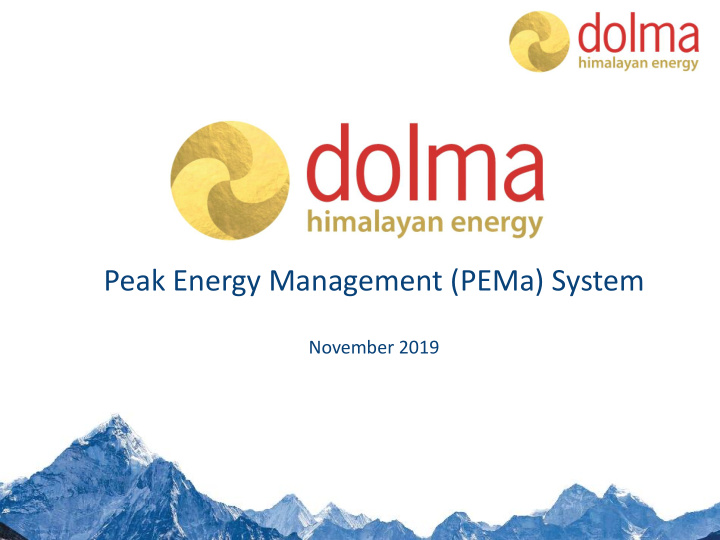



Peak Energy Management (PEMa) System November 2019
Demand-Supply – 2018 Daily Demand/Supply Curve – Wet Season Daily Demand/Supply Curve – Dry Season 1600 1600 1400 1400 1200 1200 DEMAND/SUPPLY(MW) DEMAND/SUPPLY(MW) 1000 1000 800 800 600 600 400 400 200 200 0 0 1 2 3 4 5 6 7 8 9 10 11 12 13 14 15 16 17 18 19 20 21 22 23 24 1 2 3 4 5 6 7 8 9 10 11 12 13 14 15 16 17 18 19 20 21 22 23 24 HOURS IN DAY HOURS IN DAY IPP Generation RoR Generation Peak RoR IPP Generation RoR Generation Peak RoR Storage Import PV Generation Storage Import PV Generation Battery Storage Load Shedding Demand Battery Storage Load Shedding Demand
Why Himalayan Solar?
Hydro and Solar – Complementary resources Fig. Solar seasonal complementarity • In monsoon season – there is 350 14 plenty of cloud cover and rainfall. High production from Average hours of sunlight recorded 300 12 Average recorded rainfall (mm) hydro and low production from solar plants. 250 10 • During the winter, the low 200 8 production from hydro plants 150 6 are offset by high production Hydro from solar plants. There are less 100 4 Solar clouds and despite shorter days, solar plants generate for 50 2 over 8 hours. 0 0
The Himalayan Environmental Crisis Black Carbon • Himalayas has third largest store of frozen water on earth after the North and South poles, 95% of Fig. The regional accumulation of black carbon the glaciers are melting. • Region with highest concentration of black carbon on earth (see map). • These deposits are caused by soot, emitted from wood, diesel and coal-fired power. • Glaciers feed rivers connecting 600 million people. This vulnerable population is the densest Micrograms/ pocket of Extreme Poverty (World Bank) on m 2 /year earth. • Renewable energy generation to offset fossil fuel imports would immediate reduction in Black Carbon emissions. It takes only one layer of snowfall to cover dark deposits caused by soot emission.
The Solution Solar and Energy Storage Systems (ESS)
PEMa for Nepal • PEMa is Peak Energy Management solution • A bespoke system for the electricity needs of Nepal building on Solar PV, Hydro spillage and Battery storage. • Dispatching non-intermittent power to the dry season base load deficit as well as to daily-peak load. • “Time - shifting” power from the daytime to evening peak and storing power from night-time for the morning peak. • Taking just about 2 years from PDA signing, with modular expansion possible in 6-12 months - Short time to market. • Intermittency and grid instability solved with BESS; • INPS support with ancillary services; • Delivering 150 MW PV + 20 MW storage capacity in phase 1 and up to 750 MW PV + 100 MW storage capacity by 2025.
Why Batteries? Fig A . Battery (ESS) time-shifting/capacity firming • Energy Storage Systems (ESS) or “battery storage”, has been coined as the next disruptive technology in the power sector. • PV (Photovoltaic) and ESS combined can maintain a predefined level of power for extended periods of time by time-shifting generation (fig A). • A PV + ESS system can also maintain the frequency stability to the grid which Fig B. Battery Frequency control provides consistent baseload supply from traditionally intermittent sources like PV and wind. • Lithium ion battery costs are down to 80% of what they were in 2010, making implementation economically viable.
Demand Forecast Projection Nepal Electricity Demand Forecast 10000 Peak Electricity Demand (MW) 8000 6000 4000 2000 0 2004 2006 2008 2010 2012 2014 2016 2018 2020 2022 2024 2026 2028 2030 Nepal Electricity Authority Water and Energy Commission Secreterait Investment Board of Nepal Historical 10% annual growth in historical demand
Demand-Supply – 2021 Daily Demand/Supply Curve – Dry Season Daily Demand/Supply Curve – Wet Season 1600 1600 1400 1400 1200 1200 DEMAND/SUPPLY(MW) DEMAND/SUPPLY(MW) 1000 1000 800 800 600 600 400 400 200 200 0 0 1 2 3 4 5 6 7 8 9 10 11 12 13 14 15 16 17 18 19 20 21 22 23 24 1 2 3 4 5 6 7 8 9 10 11 12 13 14 15 16 17 18 19 20 21 22 23 24 HOURS IN DAY HOURS IN DAY IPP Generation RoR Generation Peak RoR IPP Generation RoR Generation Peak RoR Storage Import PV Generation Storage Import PV Generation Battery Storage Load Shedding Demand Battery Storage Load Shedding Demand
Demand-Supply – 2025 Daily Demand/Supply Curve – Dry Season Daily Demand/Supply Curve – Wet Season 2500 2500 2000 2000 DEMAND/SUPPLY(MW) DEMAND/SUPPLY(MW) 1500 1500 1000 1000 500 500 0 0 1 2 3 4 5 6 7 8 9 10 11 12 13 14 15 16 17 18 19 20 21 22 23 24 1 2 3 4 5 6 7 8 9 10 11 12 13 14 15 16 17 18 19 20 21 22 23 24 HOURS IN DAY HOURS IN DAY IPP Generation RoR Generation Peak RoR IPP Generation RoR Generation Peak RoR Storage Import PV Generation Storage Import PV Generation Battery Storage Load Shedding Demand Battery Storage Load Shedding Demand
Development Impact Potential Sustainable Development Goals Direct Impact Increasing Nepal’s per capita electricity consumption from 150 to 300 kilowatt hour (kWh) After 8 years of commercial operation solar will become cheaper than energy imports The project will provide sustainably jobs for 2,500 during construction and 625 jobs during operation, contributing towards economic growth in various districts In its first phase, our project will offset ~249,600 tonnes of CO2 in phase 1, and ~1,300,312 tonnes of CO2 by 2022 after the final stage Indirect Impact Developing an industrial base and expertise in solar and battery technologies Providing sustainable electricity supply across Nepal
Thank you
Recommend
More recommend